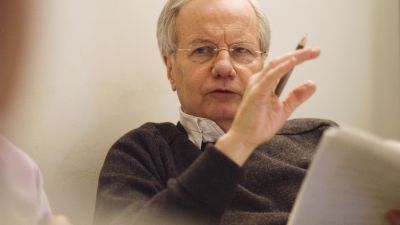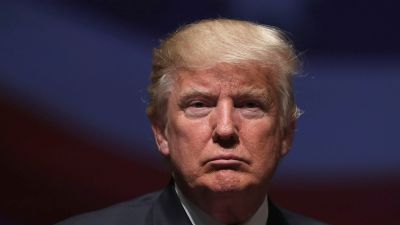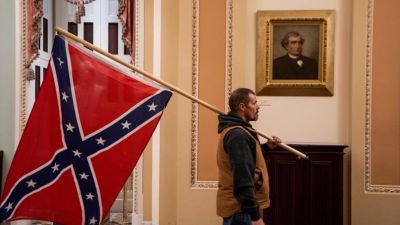
Flag of China
Despite early and repeated warnings from China and the World Health Organization, Trump downplayed the coronavirus threat for months while lulling Americans into a false sense of security. In fact, he praised China repeatedly for its transparency in dealing with COVID-19.
Then the pandemic decimated the US stock market and put millions of Americans out of work. When Trump could no longer deny the impact of the virus, he reversed course and blamed China for everything.
Stage 1: Deny and Distract
Dec. 31, 2019: China informs the WHO of an outbreak in Wuhan. At the time, 15 Trump Administration officials already embedded at WHO headquarters in Geneva begin working full time on the virus. At least six other US officials at WHO and two more working remotely dedicate most of their time to COVID-19.
Jan. 3, 2020: Dr. Robert Redfield, the director of the Centers for Disease Control and Prevention, warns Health and Human Services Secretary Alex Azar that China may have discovered a new coronavirus. Azar notifies Trump’s National Security Council.
Jan. 8: The CDC issues its first emergency alert relating to the outbreak in Wuhan.
Early January through Feb. 28: In more than a dozen classified briefings through February, the President’s Daily Brief of Intelligence Matters warns Trump directly about the serious health and economic dangers that the virus poses. During this period, Trump holds nine campaign rallies throughout the country and downplays the dangers of COVID-19.
Jan. 18: After trying for weeks, Azar finally reaches Trump by phone to tell him that COVID-19 is a serious threat. Nevertheless, for the following six weeks, Trump reassures the public that the virus is under control and will just “go away.”
Jan. 23: The WHO warns that the outbreak in China has already spread to Japan, Thailand, South Korea, and possibly Singapore. It urges all countries to prepare containment measures, including active surveillance, early detection, isolation, case management and contact tracing.
Jan. 24: Trump tweets praise for China’s “effort and transparency. It will all work out well.”
Jan. 29: In a memo circulating inside the West Wing, Trump’s top trade adviser, Peter Navarro, warns that COVID-19 could evolve “into a full-blown pandemic, imperiling the lives of millions of Americans.”
Jan. 30: On Fox News, Trump says, “China is not in great shape right now, unfortunately. But they’re working very hard. We’ll see what happens. But we’re working very closely with China and other countries.”
Also on Jan. 30: Azar again warns Trump about the virus. Trump calls him an “alarmist.”
Feb. 7: In a tweet, Trump praises China: “Just had a long and very good conversation by phone with President Xi of China. He is strong, sharp and powerfully focused on leading the counterattack on the Coronavirus.…Great discipline is taking place in China, as President Xi strongly leads what will be a very successful operation. We are working closely with China to help!”
Also on Feb. 7: The Trump administration ships almost 18 tons of medical equipment to China, including masks, gowns, gauze, respirators and other vital materials.
Feb. 10: “China is very professionally run in the sense that they have everything under control,” Trump says.
Feb. 23: Navarro circulates another memo to top Trump advisers. He warns of the “increasing probability of a full-blown COVID-19 pandemic that could infect as many as 100 million Americans, with a loss of life of as many as 1-2 million souls.”
Feb. 25: Nancy Messonnier, a senior CDC official, tells reporters that COVID-19 is likely to spread within US communities and disruptions to daily life could be “severe.” Returning from India, Trump calls Azar to complain that Messonnier is scaring the stock markets and he threatens to oust her.
Feb. 27: “Only a very small number [of COVID-19 cases] in U.S., & China numbers look to be going down. All countries working well together!” Trump tweets.
Feb. 29: “I think our relationship with China is very good,” Trump says. “We just did a big trade deal. We’re starting on another trade deal with China — a very big one. And we’ve been working very closely. They’ve been talking to our people, we’ve been talking to their people, having to do with the virus. No, our relationship with China is very good. Maybe it’s closer because of what’s happened…”
Mar. 2: Trump holds a campaign rally in Charlotte, NC. Asked if he has any qualms about attending a large stadium rally in light of the COVID-19 threat, he says, “I think it’s very safe.”
Stage 2: Deflect and Denigrate
Around Mar. 9: The White House task force receives results from a new study by the Imperial College of London projecting that the US government’s failure to act swiftly and aggressively to limit COVID-19 could result in 2 million American deaths.
Mar. 9: The S&P 500 suffers its worst single-day drop since Black Monday 1987, leaving the market index down 26 percent from its all-time high two weeks earlier.
Mar. 10: Trump retweets a post calling COVID-19 the “China virus.”
Also on Mar. 10: Testifying before the House, CDC Director Dr. Redfield says that it is “absolutely wrong and inappropriate” to call COVID-19 the Chinese coronavirus.
Mar. 12: The Dow Jones Industrial Average closes more than 28 percent below its all-time high a month earlier.
Mar. 16: In a tweet, Trump himself refers to COVID-19 as the “Chinese Virus.”
Mar. 17: Asked if he’s concerned about criticism over his use of the phrase “Chinese virus,” Trump says, “[I]t did come from China. So I think it’s a very accurate term.”
Mar. 18: Trump says that calling COVID-19 the “Chinese virus” is “not racist at all, not at all.”
Mar. 19: Trump again calls COVID-19 the “Chinese virus.” “The world is paying a very big price for what they did,” he says in a press briefing. Trump’s typed script shows the word “Corona” in coronavirus crossed out by hand and replaced with the word “Chinese.”
Mar. 24: Trump says he won’t call COVID-19 the “China virus” anymore. He’s lying.
Mar. 27: The FBI warns of an increase in hate crimes against Asian Americans as the COVID-19 crisis continues.
Apr. 14: Trump announces a halt to federal funding of the WHO, calling it “China-centric.” He says the organization took China’s assurances at face value, “even praising China for its so-called transparency.”
A reporter asks Trump, “You were just criticizing the WHO for praising China as transparent, but you were saying many of the same things about China just a couple of months ago. So, I mean, how do you square your decision to revoke funding?”
Trump doesn’t answer the question. “Well,” he says, “I did a trade deal with China, where China is supposed to be spending $250 billion in our country.”
Stage 3: Vilify
Apr. 30: Without any evidence, Trump asserts a “high degree of confidence” that the virus originated in a Wuhan, China laboratory. The same day, The New York Times reports that senior Trump Administration officials “have pushed American spy agencies to hunt for evidence to support an unsubstantiated theory” that the outbreak originated in a government lab in Wuhan.
May 6: Talking to reporters about the pandemic, Trump says, “This is worse than Pearl Harbor. This is worse than the World Trade Center. There’s never been an attack like this. And it should have never happened. It could have been stopped at the source. It could have been stopped in China. It should have been stopped right at the source, and it wasn’t.”
May 18: At the World Health Assembly, HHS Secretary Azar refers to China without naming the country, saying, “In an apparent attempt to conceal this outbreak, at least one member state made a mockery of their transparency obligations, with tremendous costs for the entire world.”
May 24: Appearing on CBS’s Face the Nation and NBC’s Meet the Press, Trump’s national security adviser claims that China knew of the coronavirus crisis in November but chose to keep it quiet. He says that the scandal is comparable to the Soviet Union’s cover-up of the 1986 Chernobyl nuclear disaster in Ukraine.
May 25: Trump tweets, “Great reviews on our handling of Covid 19, sometimes referred to as the China Virus.”
May 29: Speaking from the Rose Garden, Trump alleges, China’s cover-up of the Wuhan virus allowed the disease to spread all over the world, instigating a global pandemic that has cost more than 100,000 American lives and over a million lives worldwide.”(The global COVID-19 death total is actually 363,000.) Trump also terminates the United States’ relationship with the World Health Organization, saying that China controls it.
Defining Metrics Linger
Investigations will reveal whether China handled the pandemic appropriately in late 2019. But however damning the conclusions may be, they will not change the metrics of failure haunting Trump’s presidency. With only four percent of the world’s population, the US accounts for more than 28 percent of COVID-19 deaths, ranking America in the top ten for most deaths per million of population.
More than 130 other countries have managed to do better. Trump can’t pin that rap on China.
Read all installments of Steven Harper’s Pandemic Timeline.





